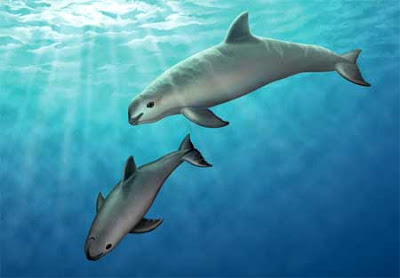Common Name: Vaquita, cochito, Gulf of California porpoise, gulf porpoise ; Cochito, marsouin du Golfe de Californie, vaquita (Fr); Cochito, vaquita(Sp)
Scientific Name: Phocoena sinus
Habitat: Tropical upwelling
Location: Upper Gulf of California, Mexico
Population: Estimated around 245 individuals
The vaquita is the smallest living cetacean, weighing up to 55 kg (120 lb). It resembles the common porpoise. The main body color is gray, darker above than below and also around the eyes and mouth. There is a dark stripe from the chin to the base of the flipper. The vaquita lives in shallow lagoons along the shoreline where there is strong tidal mixing and high productivity of the aquatic plant and animal communities.
The vaquita appears to be a non-selective feeder on small bottom-dwelling fish and squid. It swims and feeds in a leisurely manner, but it is elusive and will avoid boats of any kind. High-frequency clicks are used for echolocation. The vaquita occurs singly or in small groups, usually from 1 - 3 individuals but as many as 8 - 10.
The vaquita may have formerly occurred in Mexico throughout the Gulf of California. It was considered abundant in the early 20th century. As of the early 1980's, the only recent records of its occurrence were from the northern part of the Gulf of California. Currently it has the most limited distribution of any marine cetacean. It is restricted to the northwestern corner of the Gulf of California.
The vaquita declined in conjunction with the intensification and modernization of commercial fisheries, starting in the 1940's. Currently, the fisheries aimed at a variety of species are intensive in the upper Gulf of California, and the incidental trapping and drowning of vaquitas, particularly in gill and trawl nets, is their principal threat. In addition, the vaquita's habitat has been drastically altered by damming of the Colorado River in the USA. Long-term changes due to the reduced freshwater input are matters of concern. However, the immediate priority is to eliminate the bycatch of vaquitas in fishing gear.
Diet: All of the 17 fish species that have been found in vaquita stomachs can be classified as demersal and/or benthic species inhabiting relatively shallow water in the upper Gulf of California. The vaquita is a rather non-selective feeder on small fish and squid. Squid remains were also found in several stomach samples.
Behavior: The vaquita appears to swim and feed in a leisurely manner, but it is elusive and will avoid boats of any kind. It rises to breathe with a slow, forward-rolling movement that barely disturbs the surface of the water, and then disappears quickly, often for a long time. The vaquita uses high-frequency clicks for echolocation. Vaquita's are generally solitary animals unless accompanied by a calf.
Social Organization: The vaquita occurs singly or in small groups. One report indicated that in 58 sightings, 91 % comprised from one to three individuals, with a mean group size of 1.9 and a range of 1 - 7. Loose aggregations of vaquitas, in which they were dispersed as single individuals or as small subgroups (from two to four members, greatest number eight to ten) throughout several hundred sq m (several thousand sq ft) were also reported.
Size and weight: Length: Females - up to 1.5 m (5'); males - up to 1.4 m (4.6'). Weight: up to 55 kg (120 lb).
Age to Maturity: Females may become sexually mature at a length of approximately 1.3 m (4.4').
Gestation Period & Birth Season/Rate: The gestation period is probably 10 - 11 months. Births are thought to occur generally around late March or early April. Female vaquita's produces 1 calf annually.
Development: A vaquita calf is weaned after two to three months. The maximum observed age is 21 years.
Population status: The most recent population census calculated there are only 150 animals remaining. The mortality rate for the vaquita is estimated at 30 animals a year killed by drowning in fishing nets. If this trend continues the species will become extinct by the year 2015. There are no vaquita's in captivity to promote captive breeding to increase the population.
Previous Post : Giant Panda

Where is the bibliography?
ReplyDelete